Evidence-Based Green Human Resource Management: A Systematic Literature Review
Abstract
1. Introduction
1.1. State of the Art of GHRM
1.2. Previous Reviews of GHRM
1.3. Aims of the Research
2. Methods
2.1. Identification: Information Sources and Search Strategies
2.1.1. Information Sources
2.1.2. Search Strategies
2.2. Screening: Selection Process and Criteria
2.3. Included: Data Processing and Analyzing
3. Results and Discussion
3.1. General Overview of GHRM Literature
3.1.1. Publications by Years
3.1.2. Publications by Sources
3.1.3. Publications by Contexts
3.1.4. Publications by Methodologies
3.2. GHRM Research Foci and Trends
3.2.1. Bibliographic Coupling Analysis
3.2.2. Keyword Evolution Analysis
3.3. GHRM Conceptualizations and Research Framework
3.3.1. Dimensions and Measurements of GHRM
3.3.2. Theoretical Bases of GHRM
3.3.3. Framework of GHRM
3.4. Recommendation for Practitioners and Researchers
3.4.1. Context and Trend of GHRM
3.4.2. Access and Approach to GHRM
3.4.3. Mechanism and Innovation in GHRM
4. Conclusions
4.1. Summary of the Research
4.2. Contribution of the Research
4.3. Limitations and Proposed Solutions
Author Contributions
Funding
Institutional Review Board Statement
Informed Consent Statement
Data Availability Statement
Conflicts of Interest
References
- Jackson, S.E.; Renwick, D.W.; Jabbour, C.J.; Muller-Camen, M. State-of-the-art and future directions for green human resource management: Introduction to the special issue. Ger. J. Hum. Resour. Manag. 2011, 25, 99–116. [Google Scholar] [CrossRef]
- Panda, T.K.; Kumar, A.; Jakhar, S.; Luthra, S.; Garza-Reyes, J.A.; Kazancoglu, I.; Nayak, S.S. Social and environmental sustainability model on consumers’ altruism, green purchase intention, green brand loyalty and evangelism. J. Clean. Prod. 2020, 243, 118575. [Google Scholar] [CrossRef]
- Mensah, J. Sustainable development: Meaning, history, principles, pillars, and implications for human action: Literature review. Cogent Soc. Sci. 2019, 5, 1653531. [Google Scholar] [CrossRef]
- Zeng, H.; Li, X.; Zhou, Q.; Wang, L. Local government environmental regulatory pressures and corporate environmental strategies: Evidence from natural resource accountability audits in China. Bus. Strategy Environ. 2022, 31, 3060–3082. [Google Scholar] [CrossRef]
- Pham, N.T.; Tučková, Z.; Jabbour, C.J.C. Greening the hospitality industry: How do green human resource management practices influence organizational citizenship behavior in hotels? A mixed-methods study. Tour. Manag. 2019, 72, 386–399. [Google Scholar] [CrossRef]
- Han, H. Consumer behavior and environmental sustainability in tourism and hospitality: A review of theories, concepts, and latest research. J. Sustain. Tour. 2021, 29, 1021–1042. [Google Scholar] [CrossRef]
- González-Benito, J.; González-Benito, Ó. A study of determinant factors of stakeholder environmental pressure perceived by industrial companies. Bus. Strategy Environ. 2010, 19, 164–181. [Google Scholar] [CrossRef]
- Manaktola, K.; Jauhari, V. Exploring consumer attitude and behaviour towards green practices in the lodging industry in India. Int. J. Contemp. Hosp. Manag. 2007, 19, 364–377. [Google Scholar] [CrossRef]
- Garcés-Ayerbe, C.; Rivera-Torres, P.; Murillo-Luna, J.L. Stakeholder pressure and environmental proactivity: Moderating effect of competitive advantage expectations. Manag. Decis. 2012, 50, 189–206. [Google Scholar] [CrossRef]
- Song, W.; Yu, H. Green innovation strategy and green innovation: The roles of green creativity and green organizational identity. Corp. Soc. Responsib. Environ. Manag. 2018, 25, 135–150. [Google Scholar] [CrossRef]
- do Paço, A.; Shiel, C.; Alves, H. A new model for testing green consumer behaviour. J. Clean. Prod. 2019, 207, 998–1006. [Google Scholar] [CrossRef]
- Singh, S.K.; El-Kassar, A.-N. Role of big data analytics in developing sustainable capabilities. J. Clean. Prod. 2019, 213, 1264–1273. [Google Scholar] [CrossRef]
- Jabbour, C.J.C.; Santos, F.C.A. The central role of human resource management in the search for sustainable organizations. Int. J. Hum. Resour. Manag. 2008, 19, 2133–2154. [Google Scholar] [CrossRef]
- Renwick, D.W.; Redman, T.; Maguire, S. Green human resource management: A review and research agenda. Int. J. Manag. Rev. 2013, 15, 1–14. [Google Scholar] [CrossRef]
- Evans, P.A. The strategic outcomes of human resource management. Hum. Resour. Manag. 1986, 25, 149–167. [Google Scholar] [CrossRef]
- Benevene, P.; Buonomo, I. Green human resource management: An evidence-based systematic literature review. Sustainability 2020, 12, 5974. [Google Scholar] [CrossRef]
- Jabbour, C.J.C.; Santos, F.C.A. Relationships between human resource dimensions and environmental management in companies: Proposal of a model. J. Clean. Prod. 2008, 16, 51–58. [Google Scholar] [CrossRef]
- Jackson, S.E.; Seo, J. The greening of strategic HRM scholarship. Organ. Manag. J. 2010, 7, 278–290. [Google Scholar] [CrossRef]
- Renwick, D.; Redman, T.; Maguire, S. Green HRM: A review, process model, and research agenda. Univ. Sheff. Manag. Sch. Discuss. Pap. 2008, 1, 1–46. [Google Scholar] [CrossRef]
- Jabbour, C.J.C.; de Sousa Jabbour, A.B.L. Green human resource management and green supply chain management: Linking two emerging agendas. J. Clean. Prod. 2016, 112, 1824–1833. [Google Scholar] [CrossRef]
- Milliman, J.; Clair, J. Best environmental HRM practices in the US. In Greening People; Greenleaf Publishing: Sheffield, UK, 1996; pp. 49–74. [Google Scholar]
- Renwick, D.W.S.; Jabbour, C.J.C.; Muller-Camen, M.; Redman, T.; Wilkinson, A. Contemporary developments in Green (environmental) HRM scholarship. Int. J. Hum. Resour. Manag. 2016, 27, 114–128. [Google Scholar] [CrossRef]
- James, P. Total Quality Environmental Management and Human Resource Management. In Greening People; Greenleaf Publishing: Sheffield, UK, 1996; pp. 33–47. [Google Scholar]
- Dutta, D.S. Greening people: A strategic dimension. ZENITH Int. J. Bus. Econ. Manag. Res. 2012, 2. Available online: https://ssrn.com/abstract=2382034 (accessed on 1 June 2023).
- Jabbour, C.J.C.; Santos, F.C.A.; Nagano, M.S. Contributions of HRM throughout the stages of environmental management: Methodological triangulation applied to companies in Brazil. Int. J. Hum. Resour. Manag. 2010, 21, 1049–1089. [Google Scholar] [CrossRef]
- Gholami, H.; Rezaei, G.; Saman, M.Z.M.; Sharif, S.; Zakuan, N. State-of-the-art Green HRM System: Sustainability in the sports center in Malaysia using a multi-methods approach and opportunities for future research. J. Clean. Prod. 2016, 124, 142–163. [Google Scholar] [CrossRef]
- Ren, S.; Tang, G.; E Jackson, S. Green human resource management research in emergence: A review and future directions. Asia Pac. J. Manag. 2018, 35, 769–803. [Google Scholar] [CrossRef]
- Appelbaum, E.; Bailey, T.; Berg, P.; Kalleberg, A.L. Manufacturing Advantage: Why High-Performance Work Systems Pay off; Cornell University Press: Ithaca, NY, USA, 2000; pp. 25–63. [Google Scholar]
- Barney, J. Firm resources and sustained competitive advantage. J. Manag. 1991, 17, 99–120. [Google Scholar] [CrossRef]
- Barney, J.B. Resource-based theories of competitive advantage: A ten-year retrospective on the resource-based view. J. Manag. 2001, 27, 643–650. [Google Scholar] [CrossRef]
- Freeman, R.E. Strategic Management: A Stakeholder Approach; Cambridge University Press: Cambridge, UK, 2010. [Google Scholar]
- Connelly, B.L.; Certo, S.T.; Ireland, R.D.; Reutzel, C.R. Signaling theory: A review and assessment. J. Manag. 2011, 37, 39–67. [Google Scholar] [CrossRef]
- Edwards, J.R. An examination of competing versions of the person-environment fit approach to stress. Acad. Manag. J. 1996, 39, 292–339. [Google Scholar] [CrossRef]
- Edwards, J.R.; Shipp, A.J. The relationship between person-environment fit and outcomes: An integrative theoretical framework. In Perspectives on Organizational Fit; Psychology Press: San Francisco, CA, USA, 2007; pp. 209–258. [Google Scholar]
- Dumont, J.; Shen, J.; Deng, X. Effects of green HRM practices on employee workplace green behavior: The role of psychological green climate and employee green values. Hum. Resour. Manag. 2017, 56, 613–627. [Google Scholar] [CrossRef]
- Shafaei, A.; Nejati, M.; Mohd Yusoff, Y. Green human resource management: A two-study investigation of antecedents and outcomes. Int. J. Manpow. 2020, 41, 1041–1060. [Google Scholar] [CrossRef]
- Al-Hawari, M.A.; Quratulain, S.; Melhem, S.B. How and when frontline employees’ environmental values influence their green creativity? Examining the role of perceived work meaningfulness and green HRM practices. J. Clean. Prod. 2021, 310, 127598. [Google Scholar] [CrossRef]
- Zaid, A.A.; Jaaron, A.A.; Bon, A.T. The impact of green human resource management and green supply chain management practices on sustainable performance: An empirical study. J. Clean. Prod. 2018, 204, 965–979. [Google Scholar] [CrossRef]
- Yu, W.; Chavez, R.; Feng, M.; Wong, C.Y.; Fynes, B. Green human resource management and environmental cooperation: An ability-motivation-opportunity and contingency perspective. Int. J. Prod. Econ. 2020, 219, 224–235. [Google Scholar] [CrossRef]
- Fachada, J.; Rebelo, T.; Lourenço, P.; Dimas, I.; Martins, H. Green Human Resource Management: A Bibliometric Analysis. Adm. Sci. 2022, 12, 95. [Google Scholar] [CrossRef]
- Yong, J.Y.; Yusliza, M.-Y.; Fawehinmi, O.O. Green human resource management: A systematic literature review from 2007 to 2019. Benchmarking: Int. J. 2020, 27, 2005–2027. [Google Scholar] [CrossRef]
- Pham, N.T.; Hoang, H.T.; Phan, Q.P.T. Green human resource management: A comprehensive review and future research agenda. Int. J. Manpow. 2020, 41, 845–878. [Google Scholar] [CrossRef]
- Tanova, C.; Bayighomog, S.W. Green human resource management in service industries: The construct, antecedents, consequences, and outlook. Serv. Ind. J. 2022, 42, 412–452. [Google Scholar] [CrossRef]
- Chowdhury, S.R.; Mendy, J.; Rahman, M. A Systematic Literature Review of GHRM: Organizational Sustainable Performance Reimagined Using a New Holistic Framework. Sustainability 2023, 15, 7513. [Google Scholar] [CrossRef]
- Singh, S.K.; Del Giudice, M.; Chierici, R.; Graziano, D. Green innovation and environmental performance: The role of green transformational leadership and green human resource management. Technol. Forecast. Soc. Chang. 2020, 150, 119762. [Google Scholar] [CrossRef]
- Tang, G.; Chen, Y.; Jiang, Y.; Paillé, P.; Jia, J. Green human resource management practices: Scale development and validity. Asia Pac. J. Hum. Resour. 2018, 56, 31–55. [Google Scholar] [CrossRef]
- Shah, M. Green human resource management: Development of a valid measurement scale. Bus. Strategy Environ. 2019, 28, 771–785. [Google Scholar] [CrossRef]
- Guerci, M.; Montanari, F.; Scapolan, A.; Epifanio, A. Green and nongreen recruitment practices for attracting job applicants: Exploring independent and interactive effects. Int. J. Hum. Resour. Manag. 2016, 27, 129–150. [Google Scholar] [CrossRef]
- Cop, S.; Alola, U.V.; Alola, A.A. Perceived behavioral control as a mediator of hotels’ green training, environmental commitment, and organizational citizenship behavior: A sustainable environmental practice. Bus. Strategy Environ. 2020, 29, 3495–3508. [Google Scholar] [CrossRef]
- Liu, J.; Liu, Y.; Yang, L. Uncovering the influence mechanism between top management support and green procurement: The effect of green training. J. Clean. Prod. 2020, 251, 119674. [Google Scholar] [CrossRef]
- Pfeffer, J.; Sutton, R.I. Evidence-based management. Harv. Bus. Rev. 2006, 84, 62–74. Available online: https://hbr.org/2006/01/evidence-based-management (accessed on 1 June 2023).
- Page, M.J.; McKenzie, J.E.; Bossuyt, P.M.; Boutron, I.; Hoffmann, T.C.; Mulrow, C.D.; Shamseer, L.; Tetzlaff, J.M.; Akl, E.A.; Brennan, S.E. The PRISMA 2020 statement: An updated guideline for reporting systematic reviews. Int. J. Surg. 2021, 88, 105906. [Google Scholar] [CrossRef]
- Tranfield, D.; Denyer, D.; Smart, P. Towards a methodology for developing evidence-informed management knowledge by means of systematic review. Br. J. Manag. 2003, 14, 207–222. [Google Scholar] [CrossRef]
- Page, M.J.; Moher, D.; Bossuyt, P.M.; Boutron, I.; Hoffmann, T.C.; Mulrow, C.D.; Shamseer, L.; Tetzlaff, J.M.; Akl, E.A.; Brennan, S.E. PRISMA 2020 explanation and elaboration: Updated guidance and exemplars for reporting systematic reviews. BMJ 2021, 372, n160. [Google Scholar] [CrossRef]
- Pahlevan-Sharif, S.; Mura, P.; Wijesinghe, S.N. A systematic review of systematic reviews in tourism. J. Hosp. Tour. Manag. 2019, 39, 158–165. [Google Scholar] [CrossRef]
- Perianes-Rodriguez, A.; Waltman, L.; Van Eck, N.J. Constructing bibliometric networks: A comparison between full and fractional counting. J. Informetr. 2016, 10, 1178–1195. [Google Scholar] [CrossRef]
- Bahuguna, P.C.; Srivastava, R.; Tiwari, S. Two-decade journey of green human resource management research: A bibliometric analysis. Benchmarking Int. J. 2023, 30, 585–602. [Google Scholar] [CrossRef]
- Yu, D.; Wang, W.; Zhang, W.; Zhang, S. A bibliometric analysis of research on multiple criteria decision making. Curr. Sci. 2018, 114, 747–758. [Google Scholar] [CrossRef]
- Zhu, J.; Liu, W. A tale of two databases: The use of Web of Science and Scopus in academic papers. Scientometrics 2020, 123, 321–335. [Google Scholar] [CrossRef]
- Singh, V.K.; Singh, P.; Karmakar, M.; Leta, J.; Mayr, P. The journal coverage of Web of Science, Scopus and Dimensions: A comparative analysis. Scientometrics 2021, 126, 5113–5142. [Google Scholar] [CrossRef]
- López-Concepción, A.; Gil-Lacruz, A.I.; Saz-Gil, I. Stakeholder engagement, Csr development and Sdgs compliance: A systematic review from 2015 to 2021. Corp. Soc. Responsib. Environ. Manag. 2022, 29, 19–31. [Google Scholar] [CrossRef]
- Wagner, M. ‘Green’human resource benefits: Do they matter as determinants of environmental management system implementation? J. Bus. Ethics 2013, 114, 443–456. [Google Scholar] [CrossRef]
- Leal Filho, W.; Azul, A.M.; Wall, T.; Vasconcelos, C.R.; Salvia, A.L.; do Paço, A.; Shulla, K.; Levesque, V.; Doni, F.; Alvarez-Castañón, L. COVID-19: The impact of a global crisis on sustainable development research. Sustain. Sci. 2021, 16, 85–99. [Google Scholar] [CrossRef]
- Chen, C.; Feng, Y.; Shen, B. Managing Labor Sustainability in Digitalized Supply Chains: A Systematic Literature Review. Sustainability 2022, 14, 3895. [Google Scholar] [CrossRef]
- Tuan, L.T. Promoting employee green behavior in the Chinese and Vietnamese hospitality contexts: The roles of green human resource management practices and responsible leadership. Int. J. Hosp. Manag. 2022, 105, 103253. [Google Scholar] [CrossRef]
- Haddock-Millar, J.; Sanyal, C.; Müller-Camen, M. Green human resource management: A comparative qualitative case study of a United States multinational corporation. Int. J. Hum. Resour. Manag. 2016, 27, 192–211. [Google Scholar] [CrossRef]
- Ureña Espaillat, H.J.; Briones Penalver, A.J.; Bernal Conesa, J.A. Influencing responsible green innovation in Dominican agribusiness performance. Corp. Soc. Responsib. Environ. Manag. 2022, 29, 675–685. [Google Scholar] [CrossRef]
- Ojo, A.O. Motivational factors of pro-environmental behaviors among information technology professionals. Rev. Manag. Sci. 2022, 16, 1853–1876. [Google Scholar] [CrossRef]
- Yong, J.Y.; Yusliza, M.-Y.; Ramayah, T.; Fawehinmi, O. Nexus between green intellectual capital and green human resource management. J. Clean. Prod. 2019, 215, 364–374. [Google Scholar] [CrossRef]
- Van Eck, N.J.; Waltman, L. Visualizing bibliometric networks. In Measuring Scholarly Impact: Methods and Practice; Springer: Berlin/Heidelberg, Germany, 2014; pp. 285–320. [Google Scholar] [CrossRef]
- Bellucci, M.; Marzi, G.; Orlando, B.; Ciampi, F. Journal of Intellectual Capital: A review of emerging themes and future trends. J. Intellect. Cap. 2021, 22, 744–767. [Google Scholar] [CrossRef]
- Masri, H.A.; Jaaron, A.A. Assessing green human resources management practices in Palestinian manufacturing context: An empirical study. J. Clean. Prod. 2017, 143, 474–489. [Google Scholar] [CrossRef]
- Kim, Y.J.; Kim, W.G.; Choi, H.-M.; Phetvaroon, K. The effect of green human resource management on hotel employees’ eco-friendly behavior and environmental performance. Int. J. Hosp. Manag. 2019, 76, 83–93. [Google Scholar] [CrossRef]
- Guerci, M.; Longoni, A.; Luzzini, D. Translating stakeholder pressures into environmental performance—The mediating role of green HRM practices. Int. J. Hum. Resour. Manag. 2016, 27, 262–289. [Google Scholar] [CrossRef]
- Nejati, M.; Rabiei, S.; Jabbour, C.J.C. Envisioning the invisible: Understanding the synergy between green human resource management and green supply chain management in manufacturing firms in Iran in light of the moderating effect of employees’ resistance to change. J. Clean. Prod. 2017, 168, 163–172. [Google Scholar] [CrossRef]
- Ogbeibu, S.; Chiappetta Jabbour, C.J.; Burgess, J.; Gaskin, J.; Renwick, D.W. Green talent management and turnover intention: The roles of leader STARA competence and digital task interdependence. J. Intellect. Cap. 2022, 23, 27–55. [Google Scholar] [CrossRef]
- Bazrkar, A.; Moshiripour, A. Corporate practices of green human resources management. Foresight STI Gov. 2021, 15, 97–105. [Google Scholar] [CrossRef]
- Ghouri, A.M.; Mani, V.; Khan, M.R.; Khan, N.R.; Srivastava, A.P. Enhancing business performance through green human resource management practices: An empirical evidence from Malaysian manufacturing industry. Int. J. Product. Perform. Manag. 2020, 69, 1585–1607. [Google Scholar] [CrossRef]
- Khatoon, A.; Khan, N.A.; Parvin, F.; Wahid, M.S.; Jamal, M.T.; Azhar, S. Green HRM: Pathway towards environmental sustainability using AHP and FAHP in a nascent parsimony. Int. J. Manpow. 2022, 43, 805–826. [Google Scholar] [CrossRef]
- Marrucci, L.; Daddi, T.; Iraldo, F. The contribution of green human resource management to the circular economy and performance of environmental certified organisations. J. Clean. Prod. 2021, 319, 128859. [Google Scholar] [CrossRef]
- Muisyo, P.K.; Qin, S. Enhancing the FIRM’S green performance through green HRM: The moderating role of green innovation culture. J. Clean. Prod. 2021, 289, 125720. [Google Scholar] [CrossRef]
- Muisyo, P.K.; Qin, S.; Ho, T.H.; Julius, M.M. The effect of green HRM practices on green competitive advantage of manufacturing firms. J. Manuf. Technol. Manag. 2022, 33, 22–40. [Google Scholar] [CrossRef]
- Muisyo, P.; Su, Q.; Ho, T.H.; Julius, M.M.; Usmani, M.S. Implications of green HRM on the firm’s green competitive advantage: The mediating role of enablers of green culture. J. Manuf. Technol. Manag. 2022, 33, 308–333. [Google Scholar] [CrossRef]
- Ojo, A.O.; Tan, C.N.-L.; Alias, M. Linking green HRM practices to environmental performance through pro-environment behaviour in the information technology sector. Soc. Responsib. J. 2022, 18, 1–18. [Google Scholar] [CrossRef]
- Paillé, P.; Valéau, P.; Renwick, D.W. Leveraging green human resource practices to achieve environmental sustainability. J. Clean. Prod. 2020, 260, 121137. [Google Scholar] [CrossRef]
- Yong, J.Y.; Yusliza, M.Y.; Ramayah, T.; Seles, B.M.R.P. Testing the stakeholder pressure, relative advantage, top management commitment and green human resource management linkage. Corp. Soc. Responsib. Environ. Manag. 2022, 29, 1283–1299. [Google Scholar] [CrossRef]
- Teixeira, A.A.; Jabbour, C.J.C.; de Sousa Jabbour, A.B.L. Relationship between green management and environmental training in companies located in Brazil: A theoretical framework and case studies. Int. J. Prod. Econ. 2012, 140, 318–329. [Google Scholar] [CrossRef]
- Shields, J.; Brown, M.; Kaine, S.; Dolle-Samuel, C.; North-Samardzic, A.; McLean, P.; Johns, R.; O’Leary, P.; Plimmer, G.; Robinson, J. Managing Employee Performance & Reward: Concepts, Practices, Strategies; Cambridge University Press: Cambridge, UK, 2015. [Google Scholar]
- Pinzone, M.; Guerci, M.; Lettieri, E.; Huisingh, D. Effects of ‘green’training on pro-environmental behaviors and job satisfaction: Evidence from the Italian healthcare sector. J. Clean. Prod. 2019, 226, 221–232. [Google Scholar] [CrossRef]
- Ogbeibu, S.; Emelifeonwu, J.; Senadjki, A.; Gaskin, J.; Kaivo-oja, J. Technological turbulence and greening of team creativity, product innovation, and human resource management: Implications for sustainability. J. Clean. Prod. 2020, 244, 118703. [Google Scholar] [CrossRef]
- Amrutha, V.; Geetha, S. Linking organizational green training and voluntary workplace green behavior: Mediating role of green supporting climate and employees’ green satisfaction. J. Clean. Prod. 2021, 290, 125876. [Google Scholar] [CrossRef]
- Paillé, P.; Valéau, P. “I don’t owe you, but I am committed”: Does felt obligation matter on the effect of green training on employee environmental commitment? Organ. Environ. 2021, 34, 123–144. [Google Scholar] [CrossRef]
- Jose Chiappetta Jabbour, C. How green are HRM practices, organizational culture, learning and teamwork? A Brazilian study. Ind. Commer. Train. 2011, 43, 98–105. [Google Scholar] [CrossRef]
- Daily, B.F.; Bishop, J.W.; Massoud, J.A. The role of training and empowerment in environmental performance: A study of the Mexican maquiladora industry. Int. J. Oper. Prod. Manag. 2012, 32, 631–647. [Google Scholar] [CrossRef]
- Bos-Nehles, A.C.; Van Riemsdijk, M.J.; Kees Looise, J. Employee perceptions of line management performance: Applying the AMO theory to explain the effectiveness of line managers’ HRM implementation. Hum. Resour. Manag. 2013, 52, 861–877. [Google Scholar] [CrossRef]
- Gerhart, B. Human resources and business performance: Findings, unanswered questions, and an alternative approach. Manag. Rev. 2005, 16, 174–185. Available online: http://hdl.handle.net/10419/78948 (accessed on 1 June 2023). [CrossRef]
- Hart, S.L. A natural-resource-based view of the firm. Acad. Manag. Rev. 1995, 20, 986–1014. [Google Scholar] [CrossRef]
- Emerson, R.M. Social Exchange Theory. Annu. Rev. Sociol. 1976, 2, 335–362. Available online: http://www.jstor.org/stable/2946096 (accessed on 1 June 2023). [CrossRef]
- Ashforth, B.E.; Mael, F. Social identity theory and the organization. Acad. Manag. Rev. 1989, 14, 20–39. [Google Scholar] [CrossRef]
- Adubor, N.V.; Adeniji, A.A.; Salau, O.P.; Olajugba, O.J.; Onibudo, G.O. Exploring Green Human Resource Adoption and Corporate Sustainability in Nigerian Manufacturing Industry. Sustainability 2022, 14, 12635. [Google Scholar] [CrossRef]
- Moin, M.F.; Omar, M.K.; Wei, F.; Rasheed, M.I.; Hameed, Z. Green HRM and psychological safety: How transformational leadership drives follower’s job satisfaction. Curr. Issues Tour. 2021, 24, 2269–2277. [Google Scholar] [CrossRef]
- Farooq, R.; Zhang, Z.; Talwar, S.; Dhir, A. Do green human resource management and self-efficacy facilitate green creativity? A study of luxury hotels and resorts. J. Sustain. Tour. 2022, 30, 824–845. [Google Scholar] [CrossRef]
- Jabbour, C.J.C.; Jugend, D.; de Sousa Jabbour, A.B.L.; Gunasekaran, A.; Latan, H. Green product development and performance of Brazilian firms: Measuring the role of human and technical aspects. J. Clean. Prod. 2015, 87, 442–451. [Google Scholar] [CrossRef]
- Song, W.; Yu, H.; Xu, H. Effects of green human resource management and managerial environmental concern on green innovation. Eur. J. Innov. Manag. 2021, 24, 951–967. [Google Scholar] [CrossRef]
- Gim, G.C.; Ooi, S.K.; Teoh, S.T.; Lim, H.L.; Yeap, J.A. Green human resource management, leader–member exchange, core self-evaluations and work engagement: The mediating role of human resource management performance attributions. Int. J. Manpow. 2022, 43, 682–700. [Google Scholar] [CrossRef]
- Yong, J.Y.; Yusliza, M.Y.; Ramayah, T.; Chiappetta Jabbour, C.J.; Sehnem, S.; Mani, V. Pathways towards sustainability in manufacturing organizations: Empirical evidence on the role of green human resource management. Bus. Strategy Environ. 2020, 29, 212–228. [Google Scholar] [CrossRef]
- Mousa, S.K.; Othman, M. The impact of green human resource management practices on sustainable performance in healthcare organisations: A conceptual framework. J. Clean. Prod. 2020, 243, 118595. [Google Scholar] [CrossRef]
- Muisyo, P.K.; Qin, S.; Julius, M.M.; Ho, T.H.; Ho, T.H. Green HRM and employer branding: The role of collective affective commitment to environmental management change and environmental reputation. J. Sustain. Tour. 2022, 30, 1897–1914. [Google Scholar] [CrossRef]
- Rehman, S.U.; Kraus, S.; Shah, S.A.; Khanin, D.; Mahto, R.V. Analyzing the relationship between green innovation and environmental performance in large manufacturing firms. Technol. Forecast. Soc. Chang. 2021, 163, 120481. [Google Scholar] [CrossRef]
- Karatepe, O.M.; Hsieh, H.; Aboramadan, M. The effects of green human resource management and perceived organizational support for the environment on green and non-green hotel employee outcomes. Int. J. Hosp. Manag. 2022, 103, 103202. [Google Scholar] [CrossRef]
- Saeed, B.B.; Afsar, B.; Hafeez, S.; Khan, I.; Tahir, M.; Afridi, M.A. Promoting employee’s proenvironmental behavior through green human resource management practices. Corp. Soc. Responsib. Environ. Manag. 2019, 26, 424–438. [Google Scholar] [CrossRef]
- Fawehinmi, O.; Yusliza, M.Y.; Mohamad, Z.; Noor Faezah, J.; Muhammad, Z. Assessing the green behaviour of academics: The role of green human resource management and environmental knowledge. Int. J. Manpow. 2020, 41, 879–900. [Google Scholar] [CrossRef]
- Rubel, M.R.B.; Kee, D.M.H.; Rimi, N.N. The influence of green HRM practices on green service behaviors: The mediating effect of green knowledge sharing. Empl. Relat. Int. J. 2021, 43, 996–1015. [Google Scholar] [CrossRef]
- Chaudhary, R. Green human resource management and employee green behavior: An empirical analysis. Corp. Soc. Responsib. Environ. Manag. 2020, 27, 630–641. [Google Scholar] [CrossRef]
- Hameed, Z.; Khan, I.U.; Islam, T.; Sheikh, Z.; Naeem, R.M. Do green HRM practices influence employees’ environmental performance? Int. J. Manpow. 2020, 41, 1061–1079. [Google Scholar] [CrossRef]
- Rizvi, Y.S.; Garg, R. The simultaneous effect of green ability-motivation-opportunity and transformational leadership in environment management: The mediating role of green culture. Benchmarking Int. J. 2021, 28, 830–856. [Google Scholar] [CrossRef]
- Umrani, W.A.; Channa, N.A.; Ahmed, U.; Syed, J.; Pahi, M.H.; Ramayah, T. The laws of attraction: Role of green human resources, culture and environmental performance in the hospitality sector. Int. J. Hosp. Manag. 2022, 103, 103222. [Google Scholar] [CrossRef]
- He, J.; Morrison, A.M.; Zhang, H. Being sustainable: The three-way interactive effects of CSR, green human resource management, and responsible leadership on employee green behavior and task performance. Corp. Soc. Responsib. Environ. Manag. 2021, 28, 1043–1054. [Google Scholar] [CrossRef]
- Ren, S.; Tang, G.; Jackson, S.E. Effects of Green HRM and CEO ethical leadership on organizations’ environmental performance. Int. J. Manpow. 2021, 42, 961–983. [Google Scholar] [CrossRef]
- Roscoe, S.; Subramanian, N.; Jabbour, C.J.; Chong, T. Green human resource management and the enablers of green organisational culture: Enhancing a firm’s environmental performance for sustainable development. Bus. Strategy Environ. 2019, 28, 737–749. [Google Scholar] [CrossRef]
- Ahmed, M.; Guo, Q.; Qureshi, M.A.; Raza, S.A.; Khan, K.A.; Salam, J. Do green HR practices enhance green motivation and proactive environmental management maturity in hotel industry? Int. J. Hosp. Manag. 2021, 94, 102852. [Google Scholar] [CrossRef]
- Cabral, C.; Jabbour, C.J.C. Understanding the human side of green hospitality management. Int. J. Hosp. Manag. 2020, 88, 102389. [Google Scholar] [CrossRef]
- Islam, M.A.; Jantan, A.H.; Yusoff, Y.M.; Chong, C.W.; Hossain, M.S. Green Human Resource Management (GHRM) practices and millennial employees’ turnover intentions in tourism industry in malaysia: Moderating role of work environment. Glob. Bus. Rev. 2020. [Google Scholar] [CrossRef]
- O’Donohue, W.; Torugsa, N. The moderating effect of ‘Green’HRM on the association between proactive environmental management and financial performance in small firms. Int. J. Hum. Resour. Manag. 2016, 27, 239–261. [Google Scholar] [CrossRef]
- Yusliza, M.-Y.; Norazmi, N.A.; Jabbour, C.J.C.; Fernando, Y.; Fawehinmi, O.; Seles, B.M.R.P. Top management commitment, corporate social responsibility and green human resource management: A Malaysian study. Benchmarking: Int. J. 2019, 26, 2051–2078. [Google Scholar] [CrossRef]
- Yu, J.; Zhu, L. Corporate ambidexterity: Uncovering the antecedents of enduring sustainable performance. J. Clean. Prod. 2022, 365, 132740. [Google Scholar] [CrossRef]
- Pinzone, M.; Guerci, M.; Lettieri, E.; Redman, T. Progressing in the change journey towards sustainability in healthcare: The role of ‘Green’HRM. J. Clean. Prod. 2016, 122, 201–211. [Google Scholar] [CrossRef]
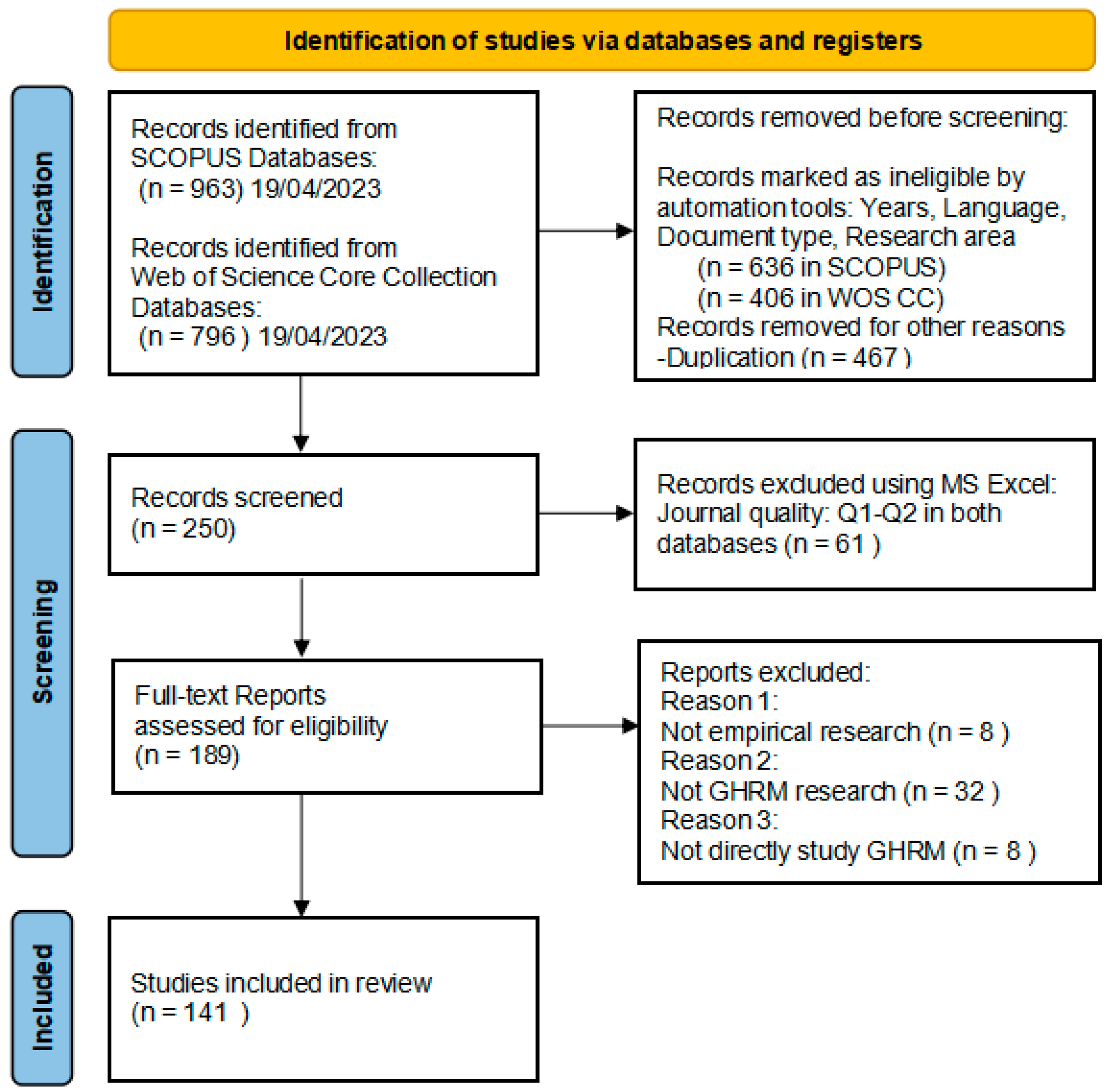
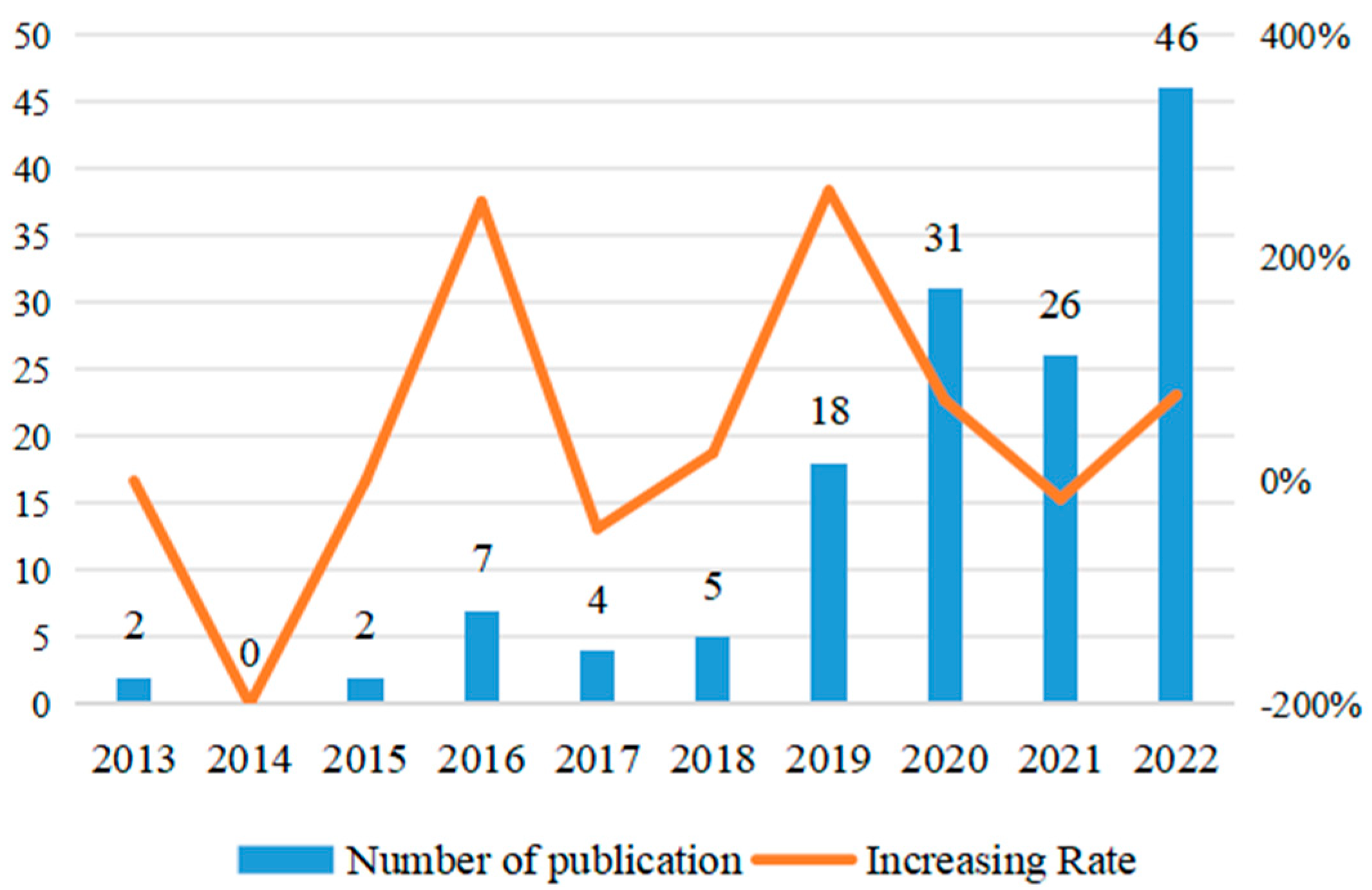
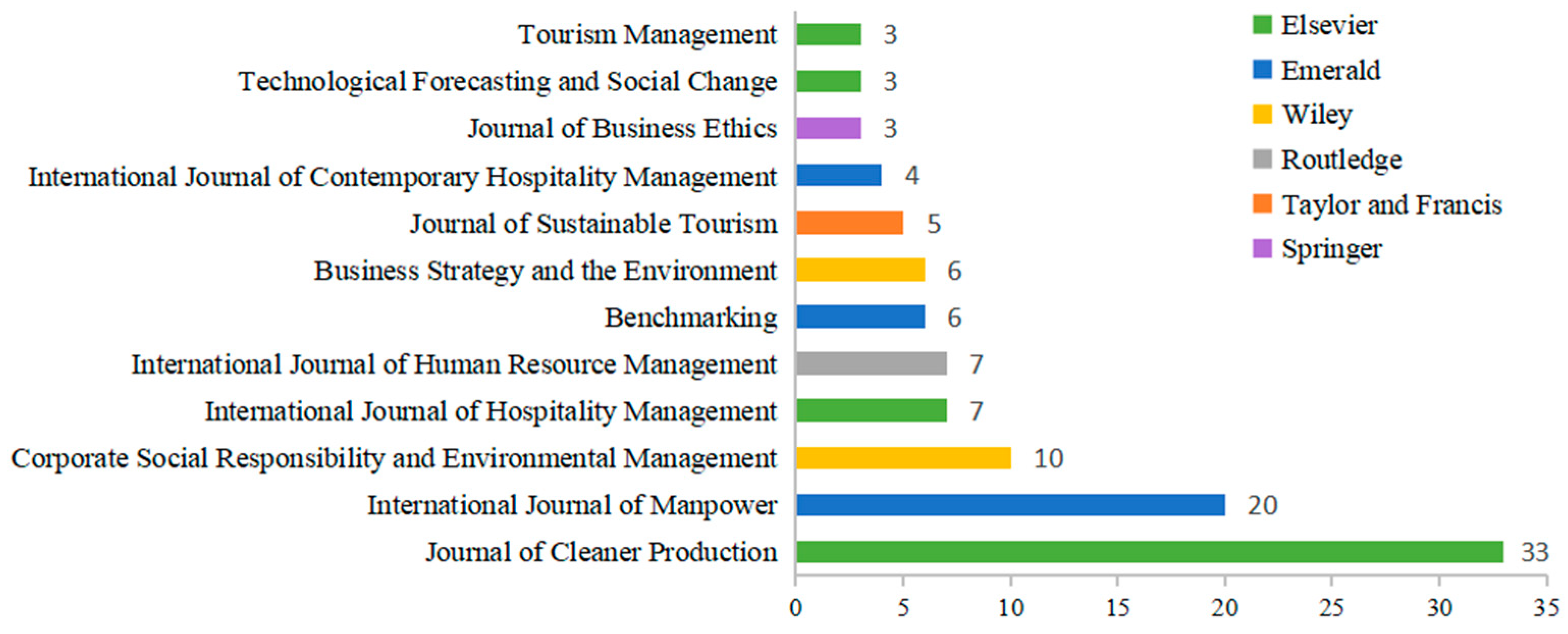
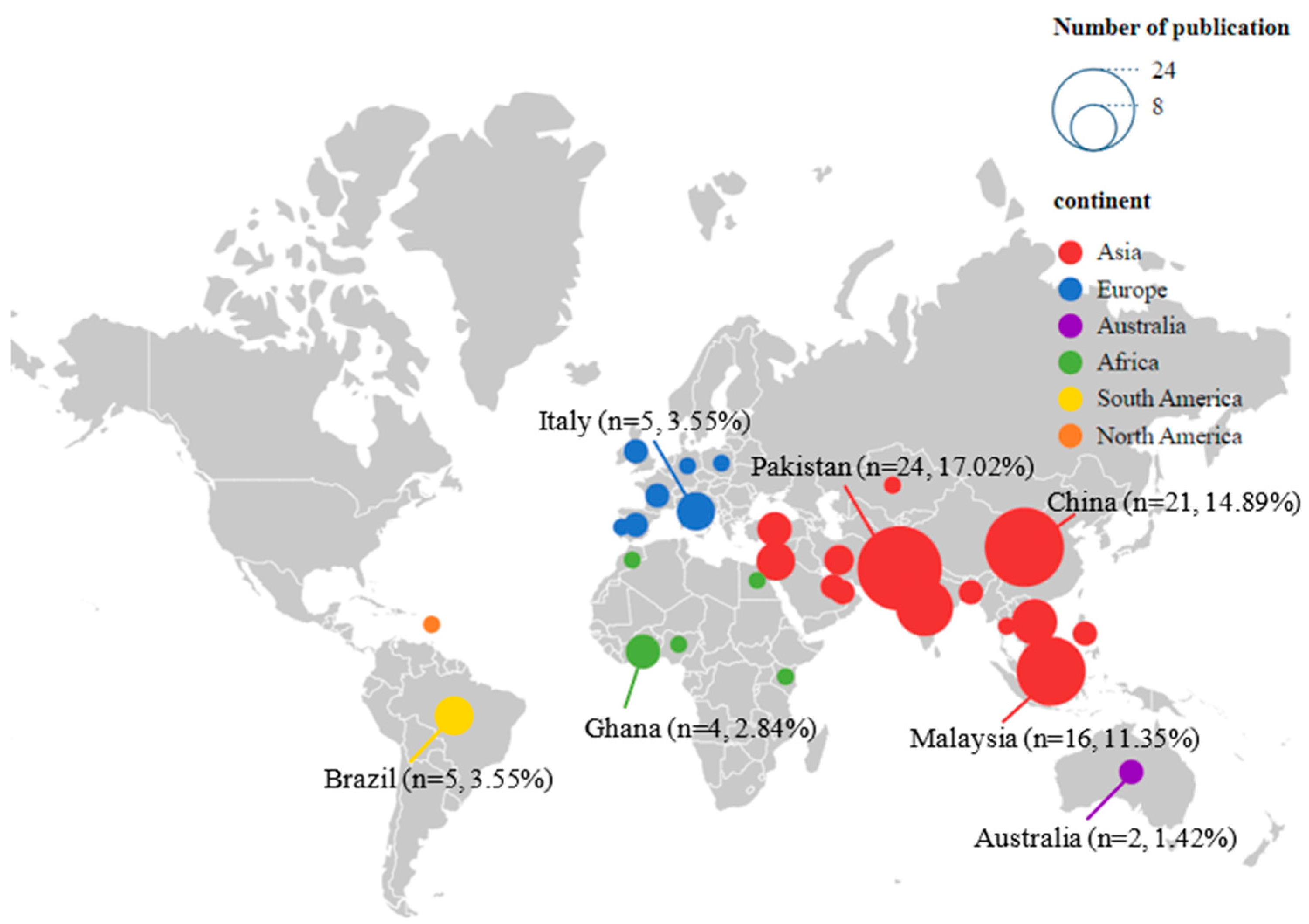
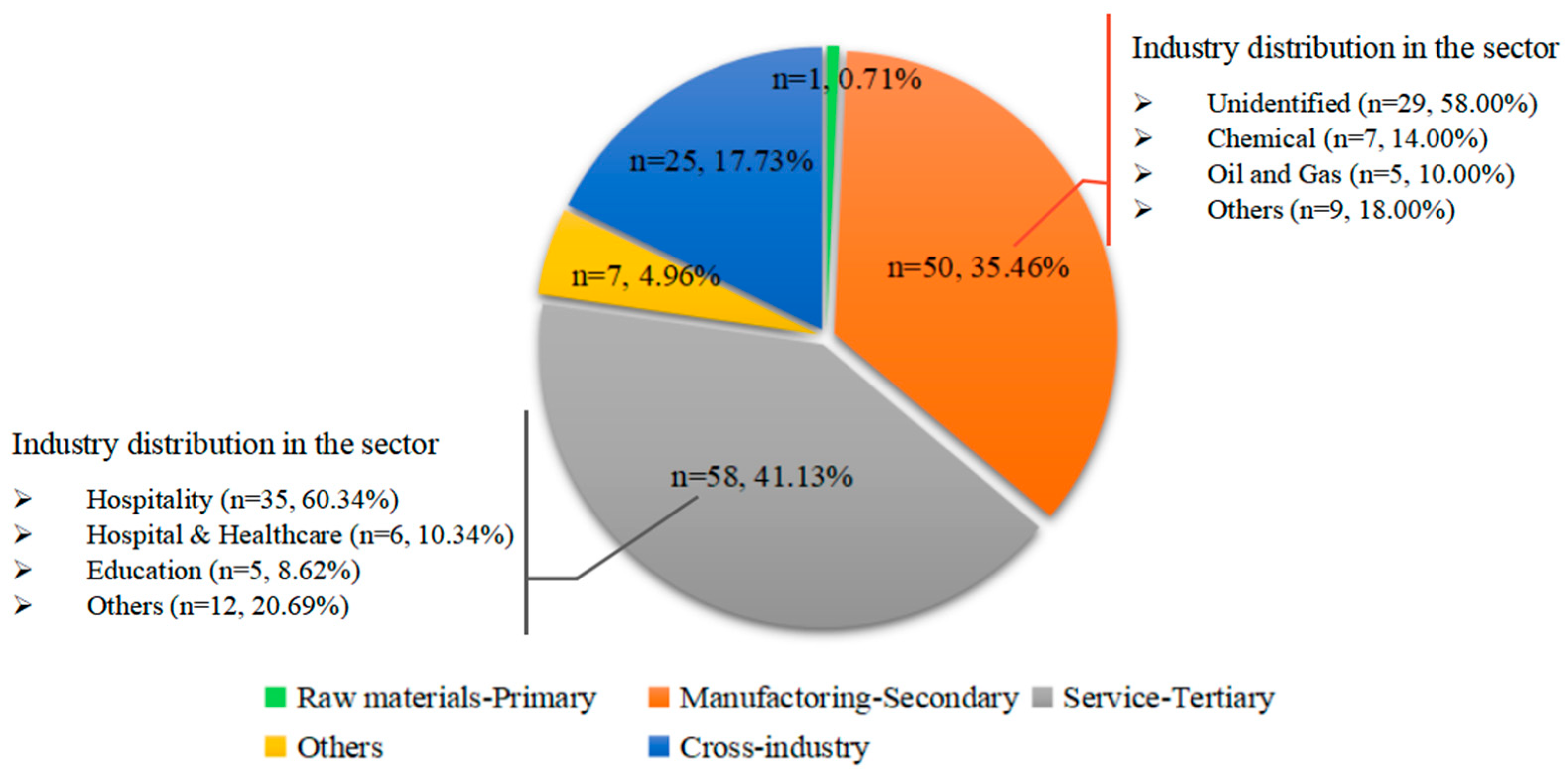
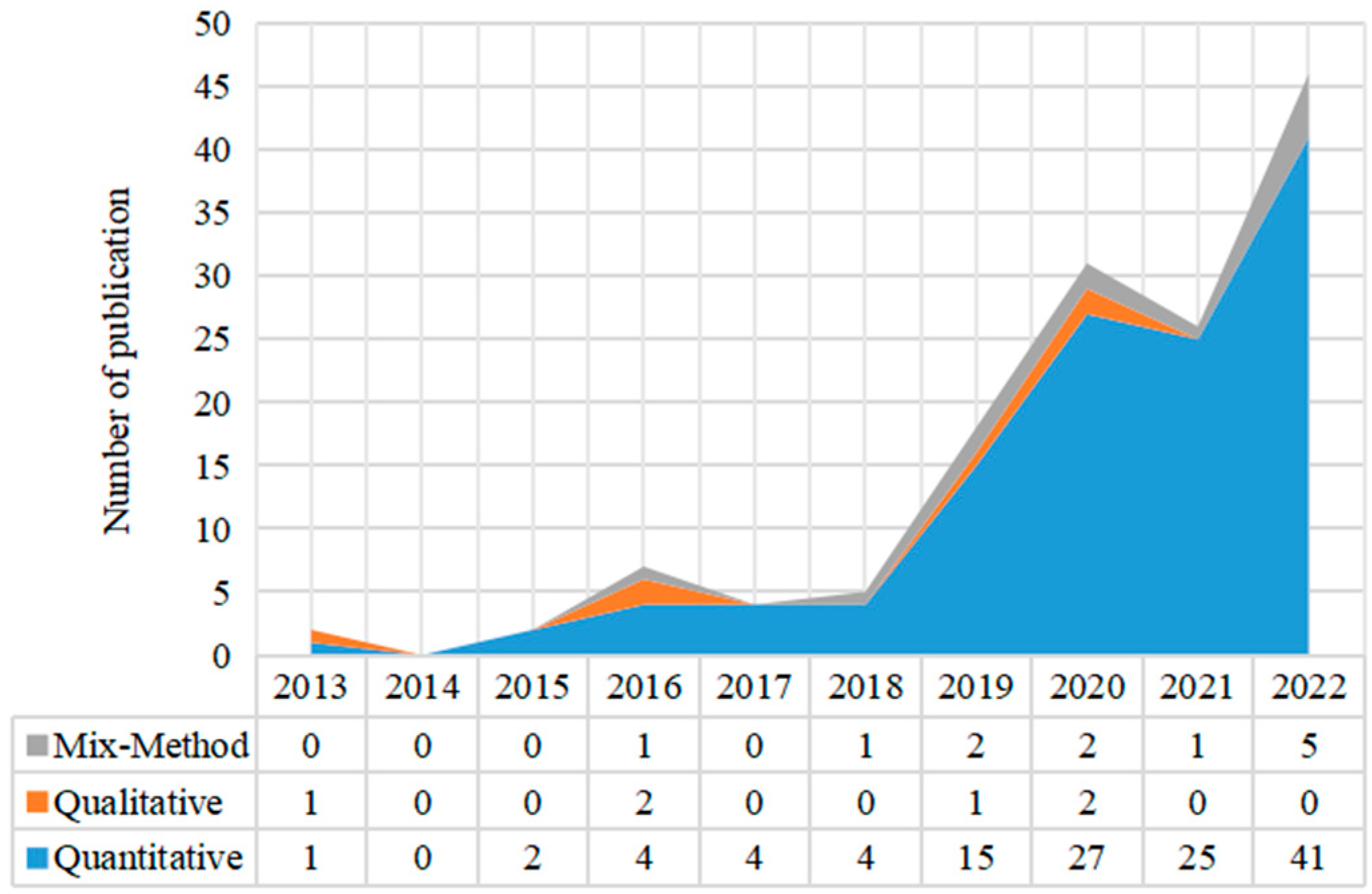
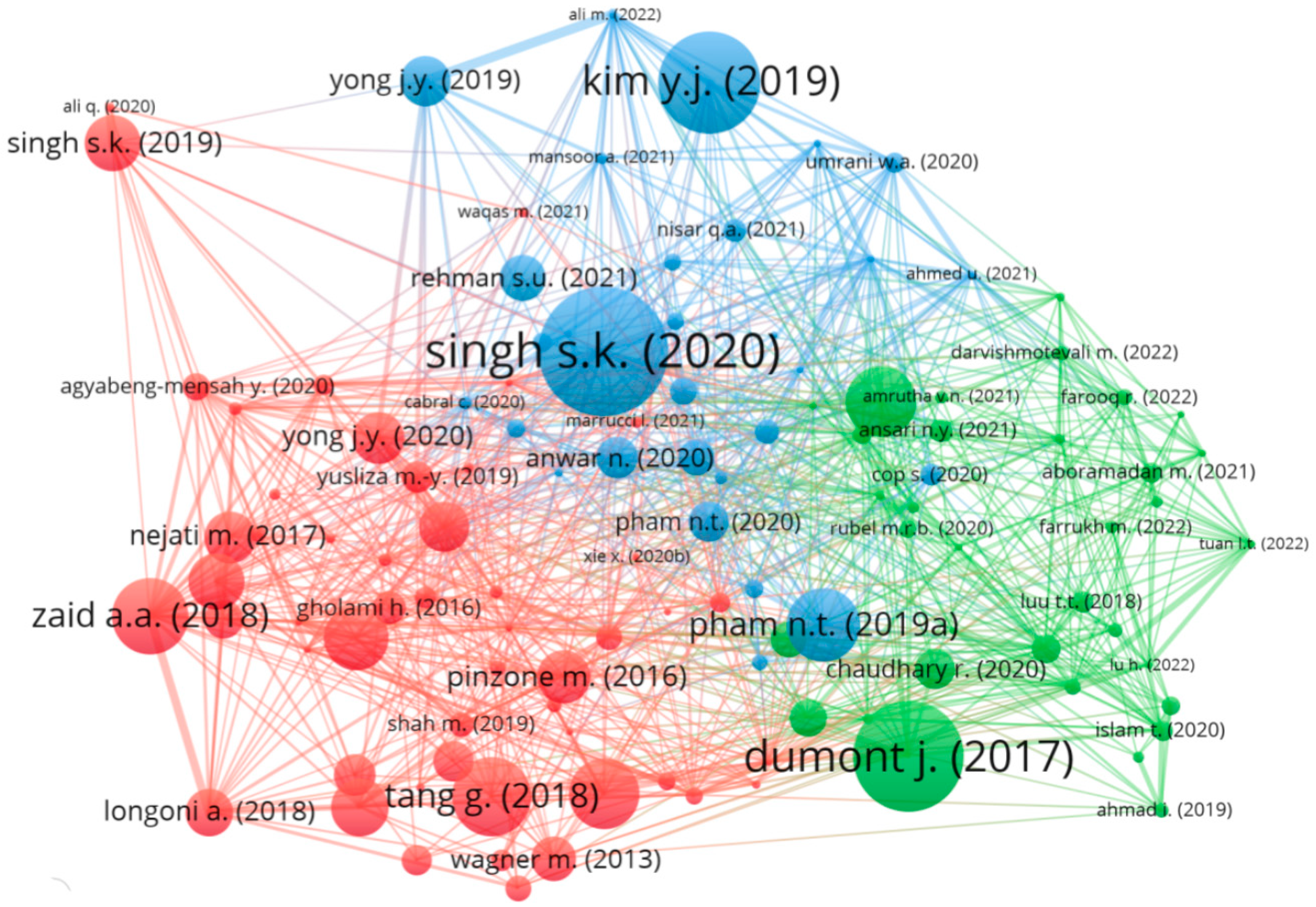
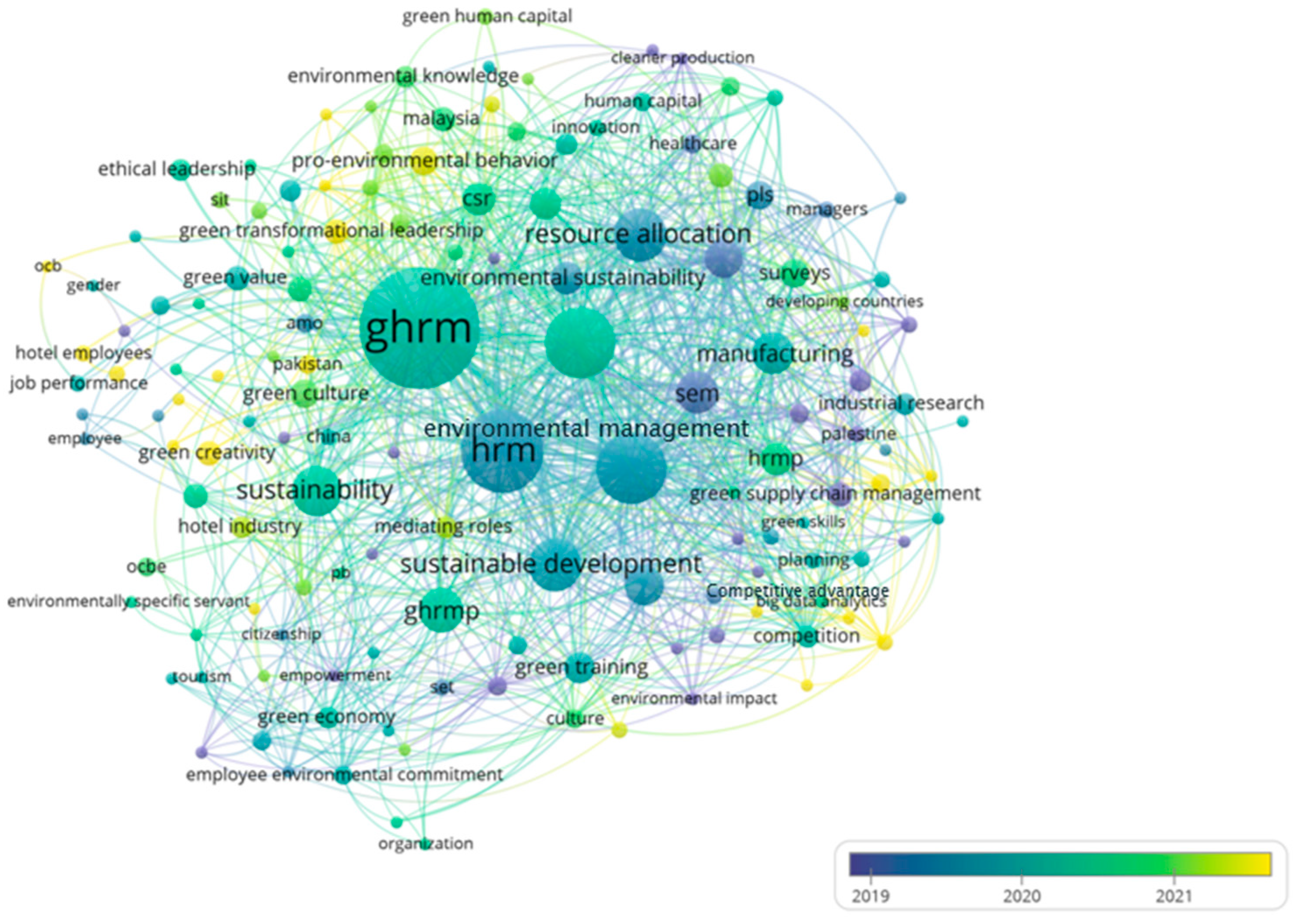
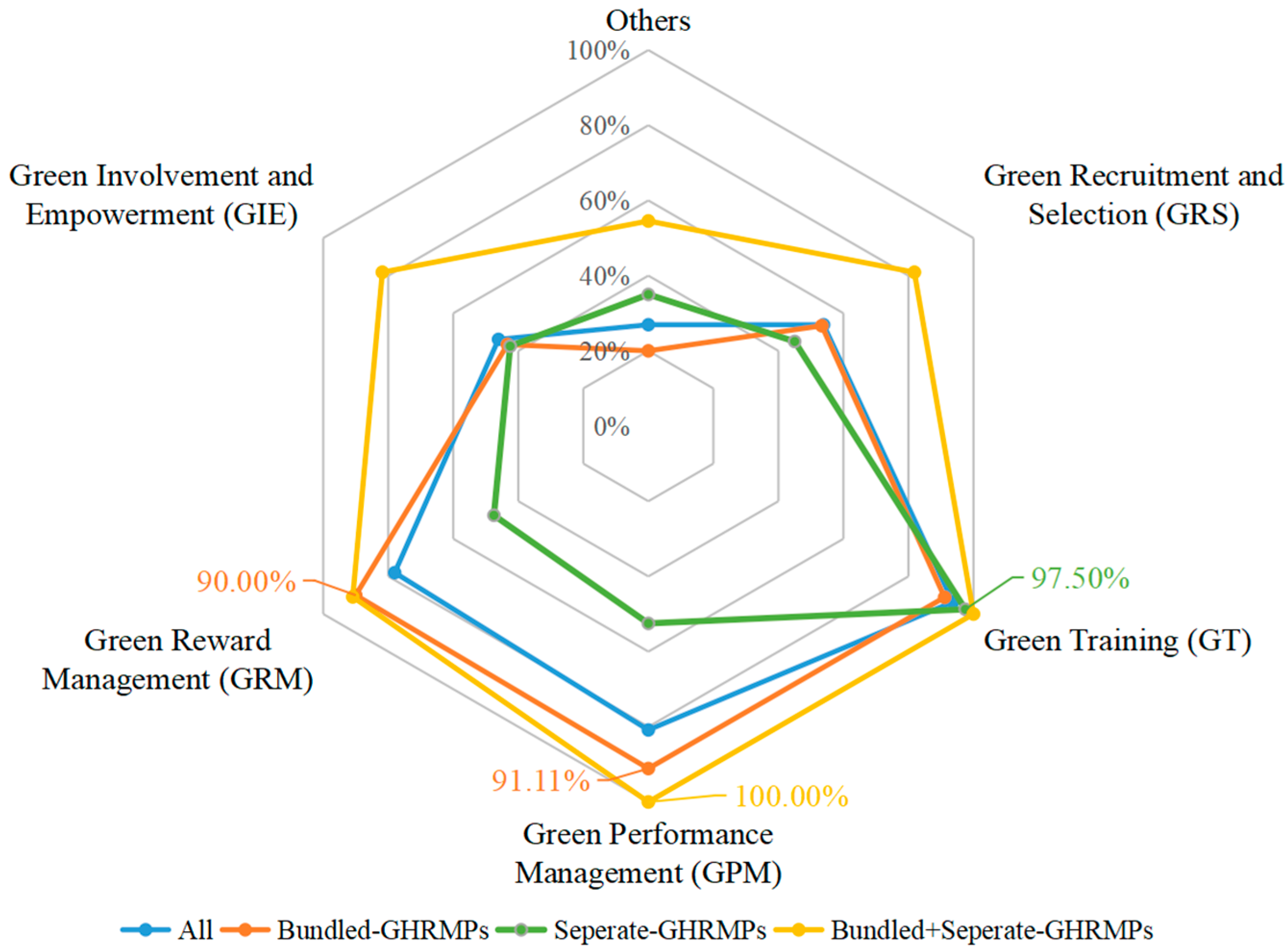
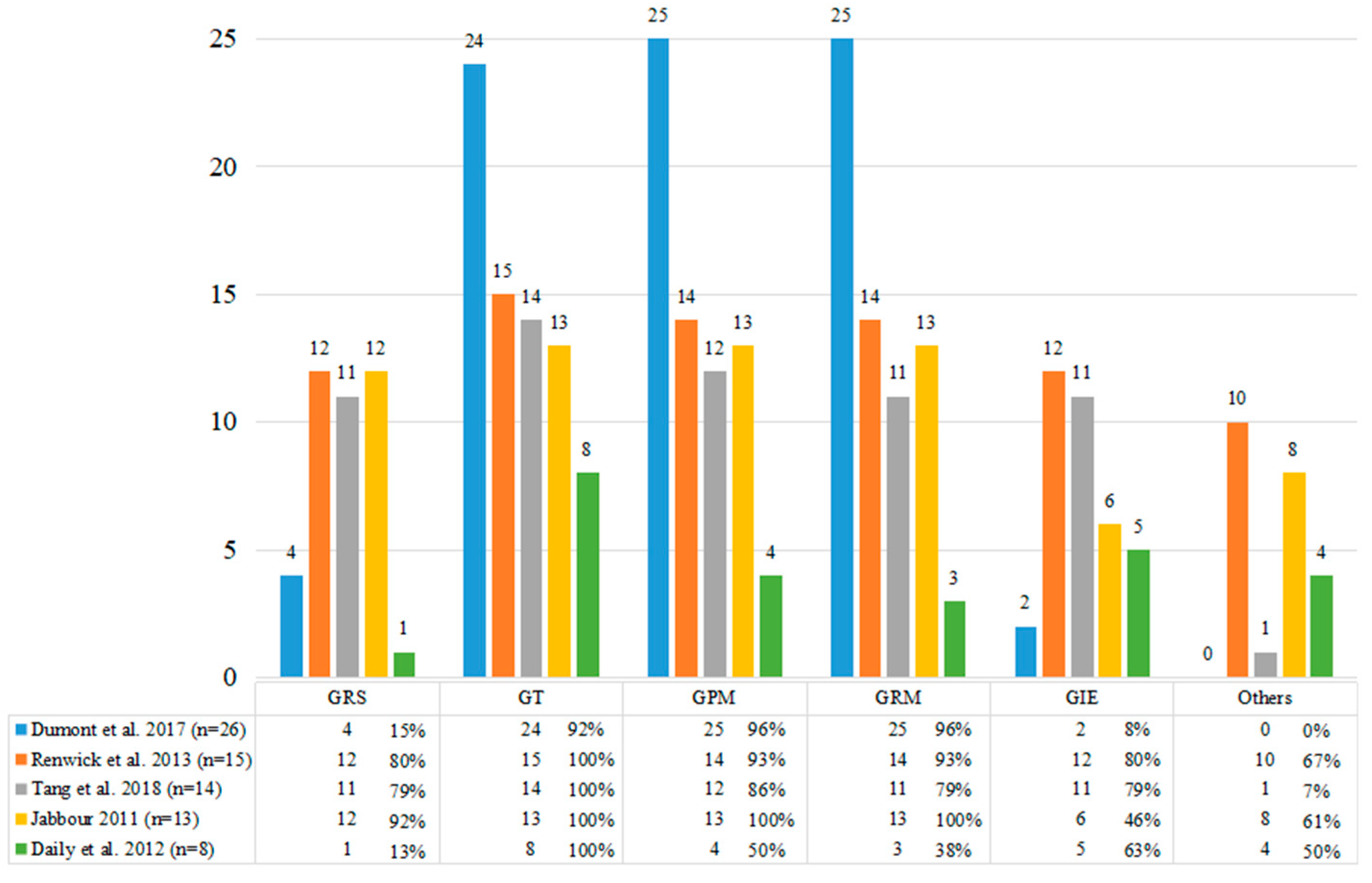
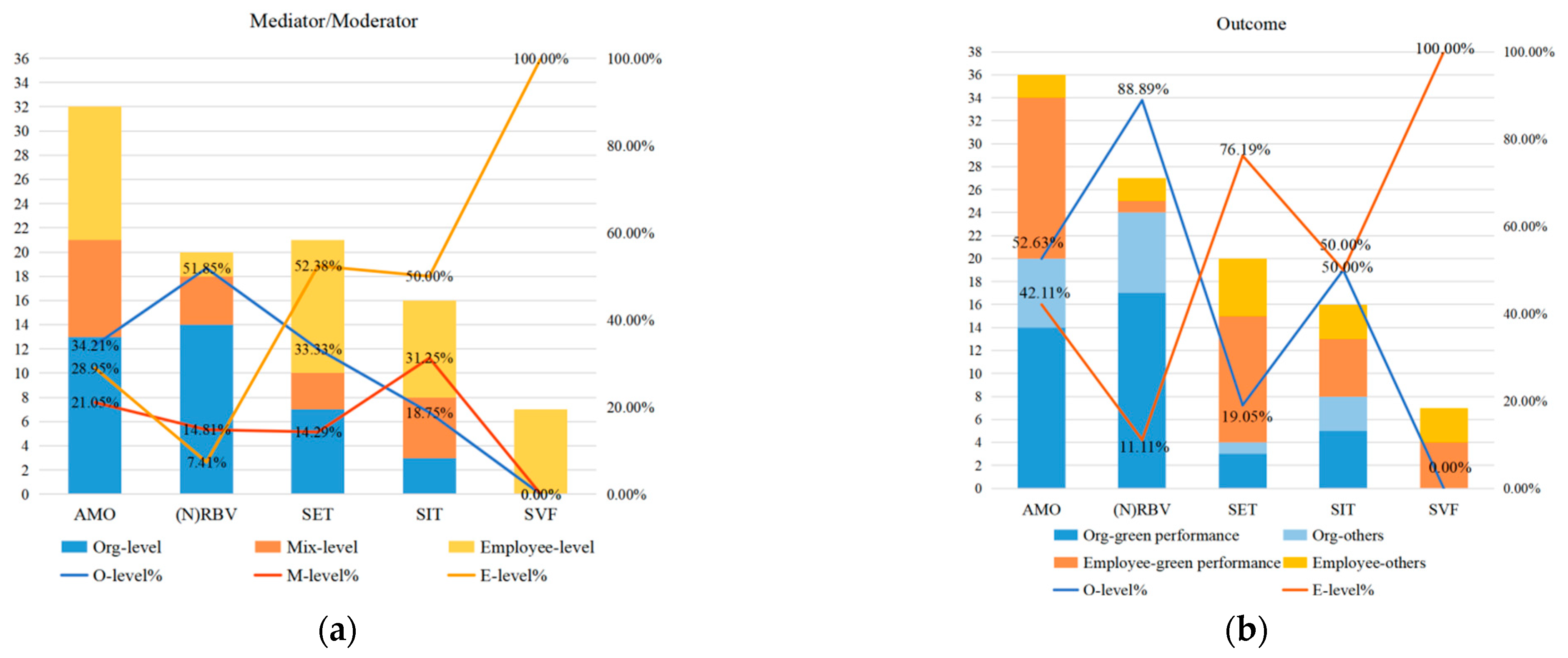

| Database | Search Terms | Eligible Criteria Set in Automatic Filters |
|---|---|---|
| N = Initial Records (searching date) | n = Records marked as ineligible | |
| Scopus | TITLE-ABS-KEY = (“green hr*” OR “green human resource*” OR “green attract*” OR “green recruit*” OR “green select*” OR “green train*” OR “green performance manag*” OR “green performance apprais*” OR “green pay*” OR “green compensat*” OR “green reward” OR “green employee*”) N = 963 (19/04/2023) | Publication years: 2022 Document type: Article Source type: Journal Publication stage: Final Subject Area: Business, Management, and Accounting Language: English n = 636 (excluded) |
| Web of Science Core Collection | TS = (“green hr*” OR “green human resource*” OR “green attract*” OR “green recruit*” OR “green select*” OR “green train*” OR “green performance manag*” OR “green performance apprais*” OR “green pay*” OR “green compensat*” OR “green reward” OR “green employee*”) N = 796 (19/04/2023) | Publication years: 2022 Document type: Article Publication stage: Final Language: English Citation Topics Meso: Management Research Area: Business Economics, Environmental Sciences Ecology, Social Sciences Other Topics n = 406 (excluded) |
| RQs | Evidence from GHRM Literature | New Findings of GHRM |
|---|---|---|
| RQ1. What is the status quo of empirical GHRM research? | 1. Significant growth varies in research disciplines; | 1. Attention from not only HRM but also across disciplines; |
| 2. Conducted context: mainly in Asia, developing economies, and the service and manufacturing sectors; | 2. Lack of evidence in the primary sector; lack of industrial description for the manufacturing sector; | |
| 3. Research clusters: theory implementing and framework extension, linking with employees, linking with an organization; | 3. Three main research streams; | |
| 4. Keyword trends: pro-environmental behavior, green creativity, and competitive advantage appeared in recent studies. | 4. Recent interests are employee-related issues. | |
| RQ2. How has GHRM been conceptualized, and how have theories been in empirical research? | 1. GHRM dimensions: most studies adopted bundled GHRMPs, and GT is among the most examined GHRMP aspect; bundled GHRMPs and GT were found positively relates to desired outcomes in most cases; | 1. Preference showed in bundled GHRMPs and GT, which show a high possibility of having positive effects; comparisons between GHRMPs were rarely made; |
| 2. Theory application: around half of the studies were based on a single theory; AMO theory was used most, followed by RBV, SET, and SIT; some recent studies used multiple theories. | 2. Tendency of using multiple theories and conducting research from different perspectives. | |
| RQ3. What suggestions can be offered for future GHRM development based on the evidence? | 1. Research that adopted the same measurement scales for GHRM constructs show similar choices in the design of GHRM dimensions; 2. Research that applied the same theories had similar inclinations of construct levels (organizational vs. employee level). | 1. Selection of GHRM dimensions influences the choice of measurement scales; 2. Theory applications interrelated with constructs choice and framework design. |
Disclaimer/Publisher’s Note: The statements, opinions and data contained in all publications are solely those of the individual author(s) and contributor(s) and not of MDPI and/or the editor(s). MDPI and/or the editor(s) disclaim responsibility for any injury to people or property resulting from any ideas, methods, instructions or products referred to in the content. |
© 2023 by the authors. Licensee MDPI, Basel, Switzerland. This article is an open access article distributed under the terms and conditions of the Creative Commons Attribution (CC BY) license (https://creativecommons.org/licenses/by/4.0/).
Share and Cite
Xie, H.; Lau, T.C. Evidence-Based Green Human Resource Management: A Systematic Literature Review. Sustainability 2023, 15, 10941. https://doi.org/10.3390/su151410941
Xie H, Lau TC. Evidence-Based Green Human Resource Management: A Systematic Literature Review. Sustainability. 2023; 15(14):10941. https://doi.org/10.3390/su151410941
Chicago/Turabian StyleXie, Huirong, and Teck Chai Lau. 2023. "Evidence-Based Green Human Resource Management: A Systematic Literature Review" Sustainability 15, no. 14: 10941. https://doi.org/10.3390/su151410941
APA StyleXie, H., & Lau, T. C. (2023). Evidence-Based Green Human Resource Management: A Systematic Literature Review. Sustainability, 15(14), 10941. https://doi.org/10.3390/su151410941






